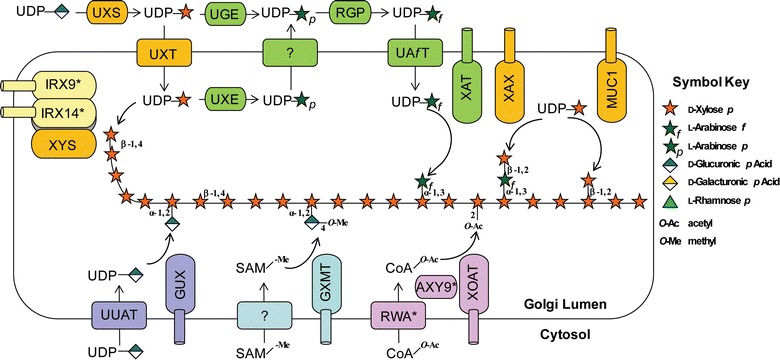Fig. 3.

Schematic model of xylan biosynthesis. Xylan biosynthesis takes place in the Golgi lumen. This process requires the generation and transport of several activated nucleotide sugars in addition to both O-acetyl and methyl donors. UDP-Xyl is generated via decarboxylation of UDP-glucuronic acid by UDP-xylose synthase (UXS) in the cytosol, and then transported into the Golgi lumen by UDP-Xyl transporters (UXT) [115]. Synthesis of the xylan backbone is catalyzed by XYS, which is part of a Golgi-localized xylan synthase complex (XSC) that also includes IRX9 and IRX14; however, the roles of the latter enzymes in this process remains enigmatic. UDP-GlcA is transported into the Golgi by a UDP-uronic acid transporter (UUAT) protein [116], and then GUX enzymes catalyze the transfer of GlcA from UDP-GlcA to the xylan backbone, which is subsequently methyl-etherified by GXMT proteins. For the addition of Araf residues, C-4 epimerization of UDP-Xyl to UDP-Arap is carried out by a Golgi-localized UDP-Xyl 4-epimerase (UXE) or cytosolic UDP-glucose 4-epimerases (UGE) [117]. UDP-Arap produced in the Golgi is either used as a substrate in the synthesis of Arap containing polysaccharides such as pectins, or transported back to the cytosol via an unknown process. In the cytosol, UDP-Arap is interconverted to UDP-Araf by UDP-Ara mutases (reversibly glycosylated polypeptide, RGP) [118], and is then transported back into the lumen of the Golgi apparatus by UDP-Araf transporters (UAfT) [119]. XAT enzymes then catalyze the addition of Araf residues to O-3 of the xylan backbone, which is often further substituted by a β-xylosyl residue to O-2 by XAX enzymes. The xylan present in Arabidopsis seed mucilage is also decorated with β-xylosyl residues at O-2, which are added by the xylosyltransferase MUC1. Acetyl donors, such as Acetyl-CoA or an unidentified acetyl donor, are most likely imported into the Golgi lumen by RWA proteins, and then acetylation of the xylan backbone occurs via a number of xylan acetyltransferases (XOAT), which have different catalytic regiospeficities. * Indicates that activity has not been biochemically confirmed
